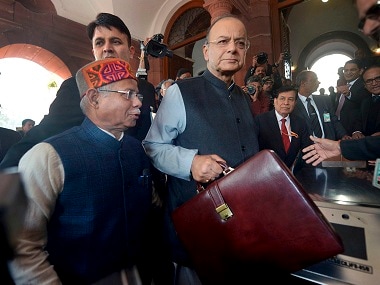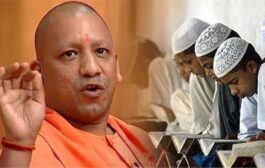Finance Minister Arun Jaitley will be presenting the interim budget on 1 February, 2019. One of his bigger headaches will be to ensure that the government is able to meet the fiscal deficit target for the current financial year (2018-2019), set in February 2018.
The fiscal deficit target for 2018-2019 was set at Rs 6,24,276 crore or 3.3 percent of the gross domestic product (GDP). Fiscal deficit is the difference between what a government earns and what it spends.
A major problem this year has been the disappointment that the government has had to face as far as collections of central Goods and Services Tax (GST) is concerned. The government had hoped to earn Rs 6,03,900 crore as central GST during the course of the year.
Between April and December 2018, the government had earned a central GST of Rs 3,41,146 crore. This leaves the government with Rs 2,62,754 crore to earn in the remaining three months of the financial year. This would mean earning a central GST of Rs 87,585 crore per month on an average for the remaining part of the financial year.
The highest central GST that the government has ever earned during a month was Rs 57,893 crore in July 2018. Given this, there is no way that the government can meet its central GST target this year. At the current rate, the gap in the actual central GST earned and the central GST that the government hoped that it would earn, will be close to Rs 1,50,000 crore.
The question is why have the GST calculations of the government gone totally haywire. The answer lies in the fact that the number and proportion of taxpayers not filing GST returns has gone up during the course of 2018-2019.
In a recent answer to a question raised in the Lok Sabha, the government had pointed out that in April 2018, 15.44 percent of the 88.2 lakh regular taxpayers hadn’t filed their GST returns. By November 2018, 28.8 percent the 98.5 lakh regular taxpayers hadn’t filed their GST returns.
As far as the composition taxpayers, who need to file their GST returns once every three months, are concerned, 19.3 percent of the 17.7 lakh taxpayers hadn’t filed their returns for the period of three months ending June 2018. For the period of three months ending September 2018, 25.4 percent of 17.7 lakh taxpayers hadn’t filed their returns.
What this tells us is that during the course of 2018-2019, more and more taxpayers did not file their GST returns and did not pay their fair share of GST as well. This has led to a huge gap in the collection of GST.
The GST Council has tried to solve this by problem by trying to simplify the GST through a spate of measures recently. But that has been too little and too late to make a significant difference to the GST collections this year.
In this scenario, what options does the finance minister really have to ensure that he gets around to meeting or getting somewhere near the original fiscal deficit target that he had set a year ago.
One way of doing this is to delay paying out the food and fertiliser subsidies. This has been standard operating procedure for the finance ministers in the past. The accounts of the government work on a cash basis and not on an accrual basis. This basically means that only when the government actually spends money is it accounted for as expenditure and not when the expenditure becomes due.
Take the case of Food Corporation of India (FCI), which buys rice and wheat from farmers directly at the minimum support price announced by the government every year and then sells that rice and wheat through the public distribution system (PDS) at a much lower price.
The government needs to compensate the FCI for offering this subsidy to the citizens of India. Instead of paying the FCI in a particular year, the government can delay the payment of this subsidy to the next financial year. And given that no money has gone out of the coffers of the government, it is not recognised as expenditure, even though the expenditure is due. The subsidies that should have been paid but are not, are referred to as a carryover liability.
The FCI continues running its operations by taking loans from public sector banks (PSBs) and issuing short-term bonds, among other things. This financing is funded by the financial system because lending to the FCI is basically deemed to be lending to the government. Even though any extra borrowing ends up on the books of the FCI, it is basically a liability that the government has to repay at the end of the day, even though it doesn’t show up on its books.
In fact, the Comptroller and Auditor General (CAG) pointed this out in a recent report. Take the case of 2016-2017, the FCI was paid Rs 78,335 crore for offering food subsidies. The carryover liability was Rs 81,303 crore. Interestingly, the carryover liability in 2011-2012 was Rs 23,427 crore. Between then and 2016-2017, it jumped to Rs 81,303 crore, as government pushed more and more payments into the future.
This basically meant that the government should have paid the FCI total of Rs 1,59,638 crore (Rs 78,335 crore + Rs 81, 303 crore) to clear all its dues. But it paid less than half of that, and the remaining part was carried forward to be paid in the years to come.
By doing this, the government managed to bring down its expenditure by Rs 81,303 crore. Along similar lines, in 2016-2017, the government paid fertiliser companies Rs 70,100 crore as fertiliser subsidy. The subsidies which weren’t paid and carried over, stood at Rs 39,057 crore.
Hence, in 2016-2017, the carryover liabilities of food and fertiliser subsidies stood at Rs 1,20,360 crore. If this expenditure hadn’t been postponed, the actual fiscal deficit of the government would have stood at 4.3% of the GDP and not 3.5% as it eventually did. The difference would have been huge.
Jaitley will have to use this trick all over again in the interim budget he is scheduled to present on 1 February, to meet the fiscal deficit target that he had set while presenting the budget in February 2018. There is no other way that such a huge shortfall in GST collections can be balanced.








































